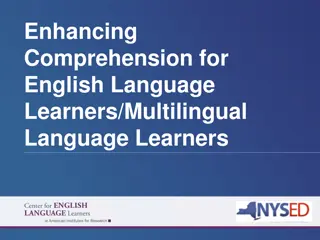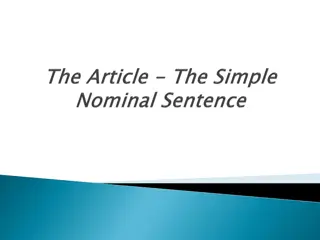Understanding Definiteness and Indefiniteness in English Language
The concept of definiteness and indefiniteness plays a crucial role in English sentence structure, encompassing uniqueness, familiarity, and existentiality. This linguistic issue varies across languages but is expressed through determiners, numbers, proper names, adjectives, and adverbs in English. Articles, such as 'a/an' and 'the', are essential in conveying definiteness. Through examples and analyses, the distinction between definite and indefinite descriptions becomes clear, highlighting the importance of context and shared knowledge between speakers and hearers.
Download Presentation

Please find below an Image/Link to download the presentation.
The content on the website is provided AS IS for your information and personal use only. It may not be sold, licensed, or shared on other websites without obtaining consent from the author. Download presentation by click this link. If you encounter any issues during the download, it is possible that the publisher has removed the file from their server.
E N D
Presentation Transcript
Definiteness And Indefiniteness In English
outline Introduction What does (in) definite mean? Uniqueness Familiarity Existentiality Forms of Definite Description In (Definite) Articles ( a/an, the) Rules of In (Definite) Articles Use In (Definite) Article Quiz Conclusion Definiteness And Indefiniteness In English
INTRODUCTION The duality of the concept of (in) definiteness is a linguistic issue that charecterrizs almost all languages but in different ways and methods. It has a semantic connotation as grammatical feature that functions in English sentence structure. The concept of (in) definiteness and forms expressing it varies from a language to another. In English, they include determiners, numbers, proper names, adjectives and adverbs that could be applied to NPs. Articles have classified by Quirk (1985:ch.5) & Swan (2004: p55) as the main category of determiners since they determine the NPs that follow. Definiteness And Indefiniteness In English
What Does (In)definite Mean? Definite and indefinite are terms which are usually applied to noun phrases * (NPs) (Abbott, B., 2004). Therefore, noun phrases which begin with the (e.g. the Queen of England, the book), are called definite descriptions . Similarly NPs which begin with a/an (an elephant, a big lie), indefinitedescriptions , are prototypical examples of indefinite NPs. * (NPs) noun phrases as defined by Swan (1995.p xxv) is: a group of words (e.g. article + adjective + noun), which acts as a subject or object complement of a clause . In other words the notion of (in) definiteness in a language is linked with the duality of the known and unknown, or specific and the common inherent in the mind of the speakers and hearers of a certain language. The presence of definite the correlates with old information. Halliday & Hasan (1976:74) a. I have a car. b. The car in the garage is mine.
The Main Features of Definite Description Uniqueness In Bertrand Russell s classic work On Denoting Phrases (1905), it means the existence of only oneentity which meets the descriptive content of the NP. a. I met an owner of the land. (There is at least one owner of the land whom I met) b. I met the owner of the land. (There is only one owner of the land whom I met who is known to both the speaker and hearer) Definiteness And Indefiniteness In English
The Main Features of Definite Description (Cont..) Familiarity A condition of the use of the is that there is a basis of understanding between speaker and hearer. This basis comprises the subjects and things known by both parties. (Christophersen 1939: 28) a. I bought a car this morning. b. I bought the car this morning. The hearer is assumed to know to be familiar to what car is meant by the speaker. The use of the definite noun phrase presupposes the existence of a referent that has been already mentioned or introduced into the discourse before. It could be; the car in the garage , or the car in front of the house . Definiteness And Indefiniteness In English
The Main Features of Definite Description (Cont..) Existentiality The existential sentences or there besentences that allow locative prepositional phrases as modifiers to follow the focus NPs. In other words they show a definiteness effect * over the sentence structure. a. There is a book in the shop window. b. There were some books on the table. * Definiteness effect means sensitivity to definiteness as a test for definiteness. (Abbott, B. 2004:122-149) Definiteness And Indefiniteness In English
Forms Of Definite Description Definiteness And Indefiniteness In English
Forms of Definite Description (Cont..) 1- Determiners is a special class of words that limits (or determines) the nouns that follow. (Murcia, C & Freeman, L. 1991: 19) 2- Numbers: cardinal numbers; first, second, etc, ordinal numbers; one, two, etc 3- Proper Nouns: names of Persons, countries , cities, , ocean, places; Ali, Iraq, Erbil .... etc 4- Adjectives; as in beautiful girl, yellow bird. 5- Adverbs; as in lovelier lady, friendlier talk. Definiteness And Indefiniteness In English
Some Rules on In(Definite) Articles Use: a: indefinite article is used before unspecific object (sing.) starts with consonants e. g She has adog. an : indefinite article is used before unspecific object (sing.) starts with vowels (a, e, i, o, u) e. g She is an English teacher. the : definite article is used before a specific object known to both the speaker and listener. e. g The teacher is very good, isn't he? Definiteness And Indefiniteness In English
Some Rules on In(Definite) Articles Use: (Cont..) Use "a /an", for the first time you speak of something, when you repeat that object use "the". e. g I ate in a Chinese restaurant. The restaurant was very good. DO NOT use an article with countries, states, or provinces, lakes and mountains except when the country is a collection of states such as "The United States". e. g They live in northern British Columbia. DO NOT use an article when you speak about things in general. e. g I like Russian tea. DO NOT use an article when you speak about meals, places, and transport. e. g He has breakfast at home.
Noun Classification for Article Use Definiteness And Indefiniteness In English
In (Definite) Article Quiz ?? Use a, an, the or (nothing). My friend is ____ fireman. Let's ask him for ____ help. There was ____ sound in ____ living room. Tom said he was _____ employee at _____ fast food restaurant. _____ restaurant is at _____ shopping mall. Jack Anderson was caught holding _____ match at _____ time of _____ fire. She replied in _____ surprise that _____ question was too much difficult. Definiteness And Indefiniteness In English
In (Definite) Article Quiz ?? The Answers a, a, the an, a, The, the a, the, , the Definiteness And Indefiniteness In English
CONCLUSION Teaching determiners to EnglishEFL and ESL learners, particularly, the (in) definite articles gives us better insights to the process of language learning. For realizing errors made by unpracticed EL learners and inexperienced teachers are now regarded as a very important tool for diagnostic purposes and have great pedagogical values in language teaching. It will help in learning English article system. It can give the curriculum developers some clues of how to present the articles in the teaching materials to be developed, and to be able design drills and exercises for those contexts in which L2 learners face the most difficulty. It is hoped that English teachers could plan their lessons and approach their teaching of English determiners in the manner that is most appropriate to their students. More practice and training on the correct use of English articles inside and outside the class is recommended. Definiteness And Indefiniteness In English
References Dr. Al Tobachi, T. & Hamood, M. : The Impact of Duality of Definiteness and Indefiniteness in Arabic on Arabic Sentence Structure with Reference to English. ADABAL-RAFIDAYN vol. (52) 1429 / 2008 Abbott, B. (2004) Definiteness and indefiniteness In Horn, L. R. & Ward, G. (eds.) Thehandbook of pragmatics. Oxford: Blackwell. 122-149. Halliday, M. A. K. (1994). An Introduction to Functional Grammar. London: Edward Arnold. (Second edition). Halliday, M.A.K. & R. Hasan (1976). Cohesion in English. England: Longman Group. Hawkins, John A. (1978) Definiteness and indefiniteness. Atlantic Highland, NJ: Humanities Press. Celce-Murcia, M. & Larsen-Freeman, D. (1991). The Grammar Book: An ESL/EFL teacher's course. Rowley: Newbury House. Crystal, D. (1985), A Dictionary of Linguistics and Phonetics, London: Blackwell. Quirk et al, R., Greenbaum, S., Leech, G. & Svartvick, J. (1985), A Grammar of Contemporary English, Longman : London Definiteness And Indefiniteness In English























